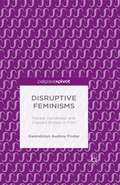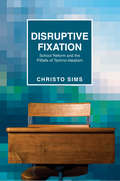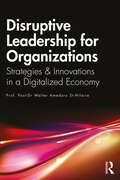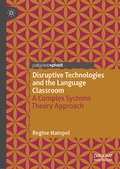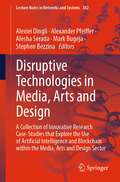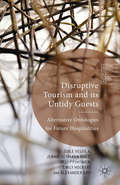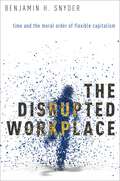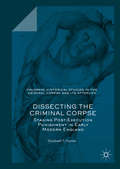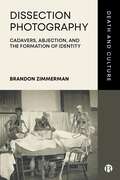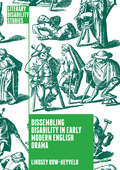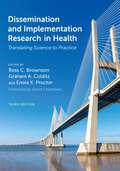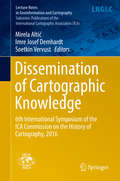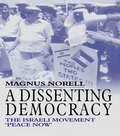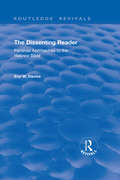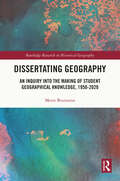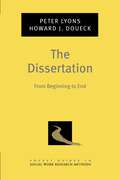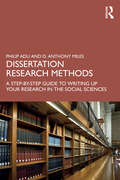- Table View
- List View
Disruptive Feminisms: Raced, Gendered, and Classed Bodies in Film
by Gwendolyn Audrey FosterDisruptive Feminisms provides a revolutionary new approach to feminism as a disruptive force. By examining various films and filmmakers who are not so obviously read as feminist or Marxist, Gwendolyn Foster showcases their ability to disrupt and effectively challenge everything from class and racism, as well as sexism, ageism, and homophobia.
Disruptive Fixation: School Reform and the Pitfalls of Techno-Idealism
by Christo SimsIn New York City in 2009, a new kind of public school opened its doors to its inaugural class of middle schoolers. Conceived by a team of game designers and progressive educational reformers and backed by prominent philanthropic foundations, it promised to reinvent the classroom for the digital age. Ethnographer Christo Sims documented the life of the school from its planning stages to the graduation of its first eighth-grade class. Disruptive Fixation is his account of how this "school for digital kids," heralded as a model of tech-driven educational reform, reverted to a more conventional type of schooling with rote learning, an emphasis on discipline, and traditional hierarchies of authority. Troubling gender and racialized class divisions also emerged.Sims shows how the philanthropic possibilities of new media technologies are repeatedly idealized even though actual interventions routinely fall short of the desired outcomes—often dramatically so. He traces the complex processes by which idealistic tech-reform perennially takes root, unsettles the worlds into which it intervenes, and eventually stabilizes in ways that remake and extend many of the social predicaments reformers hope to fix. Sims offers a nuanced look at the roles that powerful elites, experts, the media, and the intended beneficiaries of reform—in this case, the students and their parents—play in perpetuating the cycle.Disruptive Fixation offers a timely examination of techno-philanthropism and the yearnings and dilemmas it seeks to address, revealing what failed interventions do manage to accomplish—and for whom.
Disruptive Fixation: School Reform and the Pitfalls of Techno-Idealism (PDF)
by Christo SimsIn New York City in 2009, a new kind of public school opened its doors to its inaugural class of middle schoolers. Conceived by a team of game designers and progressive educational reformers and backed by prominent philanthropic foundations, it promised to reinvent the classroom for the digital age. Ethnographer Christo Sims documented the life of the school from its planning stages to the graduation of its first eighth-grade class. Disruptive Fixation is his account of how this "school for digital kids," heralded as a model of tech-driven educational reform, reverted to a more conventional type of schooling with rote learning, an emphasis on discipline, and traditional hierarchies of authority. Troubling gender and racialized class divisions also emerged.Sims shows how the philanthropic possibilities of new media technologies are repeatedly idealized even though actual interventions routinely fall short of the desired outcomes—often dramatically so. He traces the complex processes by which idealistic tech-reform perennially takes root, unsettles the worlds into which it intervenes, and eventually stabilizes in ways that remake and extend many of the social predicaments reformers hope to fix. Sims offers a nuanced look at the roles that powerful elites, experts, the media, and the intended beneficiaries of reform—in this case, the students and their parents—play in perpetuating the cycle.Disruptive Fixation offers a timely examination of techno-philanthropism and the yearnings and dilemmas it seeks to address, revealing what failed interventions do manage to accomplish—and for whom.
Disruptive Leadership for Organizations: Strategies & Innovations in a Digitalized Economy
by Walter Amedzro St-HilaireAimed as much at the neophyte as at the insider who questions why intellectual property rights (IPRs) matter in the digital age and the corporate strategies in the digitalised economy, this book approaches with perspicacity the development of disruptive mechanisms for organisations and IPR-centric leadership. The book is focused on organisations and a management systems perspective. The book identifies the technical practices and proposes multi-level strategies to promote disruptive leadership and encourage growth. The book then addresses the fundamentals of innovation and technology governance, from the production of ideas to the distribution of innovative products or services, including prototyping, financing, industrialisation and so on. It presents recent challenges, including open innovation, creativity and design thinking, and innovation of business models, placing them in the context of knowledge and the collaborative economy. The ambition of the book is to propose a framework for thought and action to the manager, which is composed of five walls – organisational creativity, intellectual property, financing, manufacturing and design of innovation – brought together under one roof, the business model of the technology. This device in which the manager must fit is situated in the strategy of his company and is to be embedded in a specific macroeconomic space.
Disruptive Leadership for Organizations: Strategies & Innovations in a Digitalized Economy
by Walter Amedzro St-HilaireAimed as much at the neophyte as at the insider who questions why intellectual property rights (IPRs) matter in the digital age and the corporate strategies in the digitalised economy, this book approaches with perspicacity the development of disruptive mechanisms for organisations and IPR-centric leadership. The book is focused on organisations and a management systems perspective. The book identifies the technical practices and proposes multi-level strategies to promote disruptive leadership and encourage growth. The book then addresses the fundamentals of innovation and technology governance, from the production of ideas to the distribution of innovative products or services, including prototyping, financing, industrialisation and so on. It presents recent challenges, including open innovation, creativity and design thinking, and innovation of business models, placing them in the context of knowledge and the collaborative economy. The ambition of the book is to propose a framework for thought and action to the manager, which is composed of five walls – organisational creativity, intellectual property, financing, manufacturing and design of innovation – brought together under one roof, the business model of the technology. This device in which the manager must fit is situated in the strategy of his company and is to be embedded in a specific macroeconomic space.
Disruptive Technologies and the Language Classroom: A Complex Systems Theory Approach
by Regine HampelAlthough new technologies are embedded in students’ lives today, there is often an assumption that their use is transparent, inconsequential, or a distraction. This book combines complex systems theory with sociocultural theory and the multimodal theory of communication, providing an innovative theoretical framework to examine how communication and meaning-making in the language classroom have developed over time, how technology impacts on meaning-making, and what the implications are for learners, teachers, institutions and policy makers. Recent studies provide evidence for the disruptive effect of technology which has resulted in a phase shift that is reshaping language education by creating new interaction patterns, allowing for multimodal communication, and introducing real-world communication into the classroom. The book proposes ways of responding to this shift before concluding that the new technologies are radically transforming the way we learn. It is likely to appeal to a range of readers, including students, academics, teachers and policy-makers.
Disruptive Technologies in Media, Arts and Design: A Collection of Innovative Research Case-Studies that Explore the Use of Artificial Intelligence and Blockchain within the Media, Arts and Design Sector (Lecture Notes in Networks and Systems #382)
by Alexiei Dingli Alexander Pfeiffer Alesha Serada Mark Bugeja Stephen BezzinaThis book presents selected proceedings from two installments of the MAD Conference in 2020—MAD Blockchain 2020 and MAD Artificial Intelligence 2020. These events focused on applications of these novel technologies in media, arts and design. A number of researchers present their own projects and practical implementations of blockchain and AI in games, art, education and sustainable living, while other authors explore theoretical and ethical questions that these technologies bring into society. First and foremost, we recommend this book to aspiring scholars and practitioners who are also building new solutions using blockchain and AI. Besides, the book extends the existing scholarship on AI and blockchain and provides proven cases and tools for education in ICT. The conference has been organized by Danube-University Krems, Drexel University Philadelphia and University of Malta with support from the MIT Education Arcade, the Texas A&M LIVE Lab and University of Vaasa.
Disruptive Tourism and its Untidy Guests: Alternative Ontologies for Future Hospitalities (Leisure Studies in a Global Era)
by Olli Pyyhtinen Emily Höckert S. Veijola J. Germann Molz E. Hockert Alexander Grit Jennie Germann MolzThis book invokes the radical potentialities of 'untidiness' to envision alternative arrangements of social life and hospitality. Instead of trying to manage sustainability or tidy up tourist situations, the authors embrace the messiness of human relations and argue for more creative, embodied and ethical ontologies of tourism and mobility.
DISRUPTIVE WORKPLACE C: Time and the Moral Order of Flexible Capitalism
by Benjamin H. SnyderThe twenty-first century workplace compels Americans to be more flexible, often at a cost to their personal well-being. In The Disrupted Workplace, Benjamin Snyder examines how three groups of American workers construct moral order in a capitalist system that demands flexibility. Snyder argues that new scheduling techniques, employment strategies, and technologies disrupt the flow and trajectory of working life, transforming how workers experience time. Work can feel both liberating and terrorizing, engrossing in the short term but unsustainable in the long term. Through a vivid portrait of workers' struggles to adapt their lives to constant disruption, The Disrupted Workplace mounts a compelling critique of the price of the flexible economy.
Dissecting the Criminal Corpse: Staging Post-Execution Punishment in Early Modern England (Palgrave Historical Studies in the Criminal Corpse and its Afterlife)
by Elizabeth T. HurrenThose convicted of homicide were hanged on the public gallows before being dissected under the Murder Act in Georgian England. Yet, from 1752, whether criminals actually died on the hanging tree or in the dissection room remained a medical mystery in early modern society. Dissecting the Criminal Corpse takes issue with the historical cliché of corpses dangling from the hangman’s rope in crime studies. Some convicted murderers did survive execution in early modern England. Establishing medical death in the heart-lungs-brain was a physical enigma. Criminals had large bull-necks, strong willpowers, and hearty survival instincts. Extreme hypothermia often disguised coma in a prisoner hanged in the winter cold. The youngest and fittest were capable of reviving on the dissection table. Many died under the lancet. Capital legislation disguised a complex medical choreography that surgeons staged. They broke the Hippocratic Oath by executing the Dangerous Dead across England from 1752 until 1832. This book is open access under a CC-BY license.
Dissection Photography: Cadavers, Abjection, and the Formation of Identity
by Brandon ZimmermanContemporary audiences are often shocked to learn that in the late 19th and early 20th centuries, medical students around the world posed for photographic portraits with their cadavers; a genre known as dissection photography. Featuring previously unseen images, stories, and anecdotes, this book explores the visual culture of death within the gross anatomy lab through the tradition of dissection photography, examining its historical aspects from both photographic and medical perspectives. The author pays particular attention to the use of dissection photographs as an expression of student identity, and as an evolving transgressive ritual intricately connected to, and eventually superseding, the act of dissection itself.
Dissection Photography: Cadavers, Abjection, and the Formation of Identity
by Brandon ZimmermanContemporary audiences are often shocked to learn that in the late 19th and early 20th centuries, medical students around the world posed for photographic portraits with their cadavers; a genre known as dissection photography. Featuring previously unseen images, stories, and anecdotes, this book explores the visual culture of death within the gross anatomy lab through the tradition of dissection photography, examining its historical aspects from both photographic and medical perspectives. The author pays particular attention to the use of dissection photographs as an expression of student identity, and as an evolving transgressive ritual intricately connected to, and eventually superseding, the act of dissection itself.
Dissembling Disability in Early Modern English Drama (Literary Disability Studies)
by Lindsey Row-HeyveldWhy do able-bodied characters fake disability in 40 early modern English plays? This book uncovers a previously unexamined theatrical tradition and explores the way counterfeit disability captivated the Renaissance stage. Through detailed case studies of both lesser-known and canonical plays (by Shakespeare, Jonson, Marston, and others), Lindsey Row-Heyveld demonstrates why counterfeit disability proved so useful to early modern playwrights. Changing approaches to almsgiving in the English Reformation led to increasing concerns about feigned disability. The theater capitalized on those concerns, using the counterfeit-disability tradition to explore issues of charity, epistemology, and spectatorship. By illuminating this neglected tradition, this book fills an important gap in both disability history and literary studies, and explores how fears of counterfeit disability created a feedback loop of performance and suspicion. The result is the still-pervasive insistence that even genuinely disabled people must perform in order to, paradoxically, prove the authenticity of their impairments.
Dissemination and Implementation Research in Health: Translating Science to Practice
by Ross C. Brownson, Graham A. Coldi TZ, Enola K. ProctorThe ultimate guide to dissemination and implementation research for public health, medicine, and the social sciences In the past twenty years, dissemination and implementation (D&I) research has sought to narrow the gap between the discovery of new knowledge and its application in public health, mental health, and health care settings. The challenges of moving research to practice and policy are universal, and future progress calls for collaborative partnerships and cross-country research. The fundamental tenet of D&I research-taking what we know about improving health and putting it into practice-must be the highest priority. Dissemination and Implementation Research in Health is the definitive roadmap to effecting change in health and science from today's leading D&I researchers. With insights from around the globe, these scholars collectively address key issues in the field including how to evaluate evidence based on effective interventions, how to design an appropriate study, and how to track a set of essential outcomes. Their work has been updated in this third edition with a strong focus on health equity and new chapters on de-implementation, scale-up and sustainment, and training and capacity building. This new edition also focuses on barriers to uptake of evidence-based interventions in the communities where people live their lives and from the social service agencies, hospitals, and clinics where they receive care. Now in its third edition, Dissemination and Implementation Research in Health remains the quintessential guide to making research more consequential for researchers and practitioners in health and the social sciences.
Dissemination and Implementation Research in Health: Translating Science to Practice
The ultimate guide to dissemination and implementation research for public health, medicine, and the social sciences In the past twenty years, dissemination and implementation (D&I) research has sought to narrow the gap between the discovery of new knowledge and its application in public health, mental health, and health care settings. The challenges of moving research to practice and policy are universal, and future progress calls for collaborative partnerships and cross-country research. The fundamental tenet of D&I research-taking what we know about improving health and putting it into practice-must be the highest priority. Dissemination and Implementation Research in Health is the definitive roadmap to effecting change in health and science from today's leading D&I researchers. With insights from around the globe, these scholars collectively address key issues in the field including how to evaluate evidence based on effective interventions, how to design an appropriate study, and how to track a set of essential outcomes. Their work has been updated in this third edition with a strong focus on health equity and new chapters on de-implementation, scale-up and sustainment, and training and capacity building. This new edition also focuses on barriers to uptake of evidence-based interventions in the communities where people live their lives and from the social service agencies, hospitals, and clinics where they receive care. Now in its third edition, Dissemination and Implementation Research in Health remains the quintessential guide to making research more consequential for researchers and practitioners in health and the social sciences.
Dissemination of Cartographic Knowledge: 6th International Symposium of the ICA Commission on the History of Cartography, 2016 (Lecture Notes in Geoinformation and Cartography)
by Mirela Altić Imre Josef Demhardt Soetkin VervustThis book gathers 22 papers which were presented at the 6th International Symposium of the ICA Commission on the History of Cartography in Dubrovnik, Croatia on 13–15 October 2016. The overall conference theme was ‘The Dissemination of Cartographic Knowledge: Production – Trade – Consumption – Preservation’. The book presents original research by internationally respected authors in the field of historical cartography, offering a significant contribution to the development of this field of study, but also of geography, history and the GIS sciences. The primary target audience includes researchers, educators, postgraduate students, map librarians and archivists.
A Dissenting Democracy: The Israeli Movement 'Peace Now' (Israeli History, Politics and Society #No. 18)
by Magnus NorellA Dissenting Democracy explores the tension between the will of the whole of Israeli society and the right of the individual conscience to take precedence over that collective will. The author explores the dilemmas that stem from such an individual stance in relation to Jewish political culture.
A Dissenting Democracy: The Israeli Movement 'Peace Now' (Israeli History, Politics and Society)
by Magnus NorellA Dissenting Democracy explores the tension between the will of the whole of Israeli society and the right of the individual conscience to take precedence over that collective will. The author explores the dilemmas that stem from such an individual stance in relation to Jewish political culture.
The Dissenting Reader: Feminist Approaches to the Hebrew Bible
by Eryll Wynn DaviesThis title was first published in 2003. Few would deny that the Bible is an overwhelmingly patriarchal book that, over the centuries, has exercised considerable influence on the way in which women are perceived in society. From the opening chapters of Genesis, where woman is created to serve as man's "helper", to the pronouncements of Paul concerning the submission of wives to their husbands and the silencing of women in communal worship, the primary emphasis of the Bible is on woman's subordinate status. Feminist biblical critics raise the obvious question: how should women in communities of faith respond to the Bible's largely negative appraisal of women and oppressive patriarchal emphasis? Eryl Davies introduces the wide range of feminist approaches to the Hebrew Bible: from critics who recover neglected perspectives in the biblical tradition and argue that the Bible is not oppressively patriarchal, to others who reject biblical traditions, arguing that they are so immersed in a patriarchal culture that no parts are worth redeeming. Davies suggests that the most promising approach deploys a reader-oriented literary approach to the Hebrew Bible: by focusing on the literary representation of women through plot, dialogue and characterization, some of the subtle ways in which biblical authors sought to reinforce patriarchal values and endorse women's inferior status are highlighted. Davies argues that readers of the Hebrew Bible must be prepared to question and challenge the values and assumptions inherent in the text: they must don the mantle of the "dissenting reader" and apply what feminist biblical critics have termed a "hermeneutic of suspicion" to its content without denouncing the authority of the Bible as a sacred text.
The Dissenting Reader: Feminist Approaches to the Hebrew Bible
by Eryll Wynn DaviesThis title was first published in 2003. Few would deny that the Bible is an overwhelmingly patriarchal book that, over the centuries, has exercised considerable influence on the way in which women are perceived in society. From the opening chapters of Genesis, where woman is created to serve as man's "helper", to the pronouncements of Paul concerning the submission of wives to their husbands and the silencing of women in communal worship, the primary emphasis of the Bible is on woman's subordinate status. Feminist biblical critics raise the obvious question: how should women in communities of faith respond to the Bible's largely negative appraisal of women and oppressive patriarchal emphasis? Eryl Davies introduces the wide range of feminist approaches to the Hebrew Bible: from critics who recover neglected perspectives in the biblical tradition and argue that the Bible is not oppressively patriarchal, to others who reject biblical traditions, arguing that they are so immersed in a patriarchal culture that no parts are worth redeeming. Davies suggests that the most promising approach deploys a reader-oriented literary approach to the Hebrew Bible: by focusing on the literary representation of women through plot, dialogue and characterization, some of the subtle ways in which biblical authors sought to reinforce patriarchal values and endorse women's inferior status are highlighted. Davies argues that readers of the Hebrew Bible must be prepared to question and challenge the values and assumptions inherent in the text: they must don the mantle of the "dissenting reader" and apply what feminist biblical critics have termed a "hermeneutic of suspicion" to its content without denouncing the authority of the Bible as a sacred text.
Dissertating Geography: An Inquiry into the Making of Student Geographical Knowledge, 1950-2020 (Routledge Research in Historical Geography)
by Mette BruinsmaThis book examines the history of geography (1950-2020) from a bottom-up perspective. Disciplinary histories often emphasise the pronouncements of established academics, yet student-geographers make up the majority of the overall ‘geographical community’ at any one time. Exploring these efforts of geography students over the last seventy years places the known history of the discipline in a new perspective. A disciplinary history ‘from below’ recognises and acknowledges student dissertations and advances three core propositions: first, they are produced by an overlooked but nonetheless central grouping in the geographical community; second, the rich archival collection of dissertations specifically consulted here contains many excellent geographical knowledge productions that have remained barely read, until now; and third, there is a wish to encourage others to explore similar collections of student knowledge productions held elsewhere. This book will be an important resource for scholars and postgraduate students in Geography, Education and the History and Theory of Geography.
Dissertating Geography: An Inquiry into the Making of Student Geographical Knowledge, 1950-2020 (Routledge Research in Historical Geography)
by Mette BruinsmaThis book examines the history of geography (1950-2020) from a bottom-up perspective. Disciplinary histories often emphasise the pronouncements of established academics, yet student-geographers make up the majority of the overall ‘geographical community’ at any one time. Exploring these efforts of geography students over the last seventy years places the known history of the discipline in a new perspective. A disciplinary history ‘from below’ recognises and acknowledges student dissertations and advances three core propositions: first, they are produced by an overlooked but nonetheless central grouping in the geographical community; second, the rich archival collection of dissertations specifically consulted here contains many excellent geographical knowledge productions that have remained barely read, until now; and third, there is a wish to encourage others to explore similar collections of student knowledge productions held elsewhere. This book will be an important resource for scholars and postgraduate students in Geography, Education and the History and Theory of Geography.
The Dissertation: From Beginning to End (Pocket Guide to Social Work Research Methods)
by Peter Lyons Howard J. DoueckMany otherwise strong doctoral students get stuck at the dissertation stage, but this trusty guide takes students from the early planning phase to finishing the final draft. It contains straightforward advice for each stage of the dissertation process: selecting a chair, completing the literature review, developing a hypothesis, selecting a study sample and appropriate measures, managing and analyzing both quantitative and qualitative data, establishing good writing habits, and overcoming obstacles to completing the dissertation on schedule. Practical guidelines, tips and strategies, and action steps checklists in each chapter make this a handy pocket guide for students as well as advisors seeking a comprehensive, unintimidating road map to the social work dissertation.
Dissertation Research Methods: A Step-by-Step Guide to Writing Up Your Research in the Social Sciences
by Philip Adu D. Anthony MilesDissertation Research Methods: A Step-by-Step Guide to Writing Up Your Research in the Social Sciences focuses specifically on the methodology for planning, writing and submitting your dissertation thesis. Written by two methodology experts in the social sciences, the book provides a step-by-step guide through each stage of the dissertation process. It covers all aspects of the methodological considerations needed, from choosing a topic or research question, developing a literature review, identifying research gaps, accessing potential study participants, utilizing the right sampling strategies, analyzing data and writing up findings. Readers are introduced to the main research methods normally used in dissertations and their characteristics, and they are guided to choose an appropriate research method for their study, provide a substantial description of the selected method and articulate strong arguments in support of it. The book is filled with templates, exemplars and tools to help students write about methodology in their thesis and to equip readers to successfully troubleshoot any methodology challenges they may face. This compact book will be of use to all graduate students and their supervisors in the Social Sciences and Education and Behavioural Sciences who are looking for a guide to working with robust and defensible methodological principles in their dissertation research and theses.
Dissertation Research Methods: A Step-by-Step Guide to Writing Up Your Research in the Social Sciences
by Philip Adu D. Anthony MilesDissertation Research Methods: A Step-by-Step Guide to Writing Up Your Research in the Social Sciences focuses specifically on the methodology for planning, writing and submitting your dissertation thesis. Written by two methodology experts in the social sciences, the book provides a step-by-step guide through each stage of the dissertation process. It covers all aspects of the methodological considerations needed, from choosing a topic or research question, developing a literature review, identifying research gaps, accessing potential study participants, utilizing the right sampling strategies, analyzing data and writing up findings. Readers are introduced to the main research methods normally used in dissertations and their characteristics, and they are guided to choose an appropriate research method for their study, provide a substantial description of the selected method and articulate strong arguments in support of it. The book is filled with templates, exemplars and tools to help students write about methodology in their thesis and to equip readers to successfully troubleshoot any methodology challenges they may face. This compact book will be of use to all graduate students and their supervisors in the Social Sciences and Education and Behavioural Sciences who are looking for a guide to working with robust and defensible methodological principles in their dissertation research and theses.
